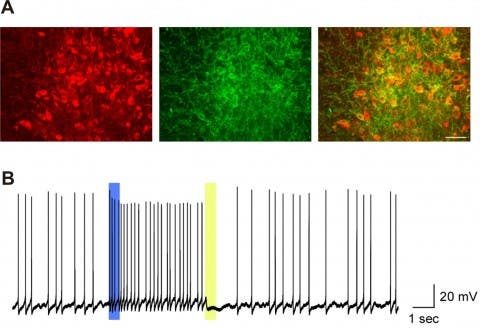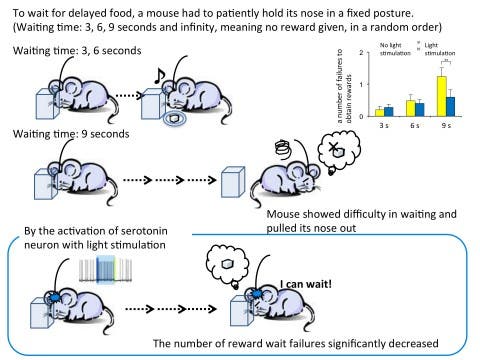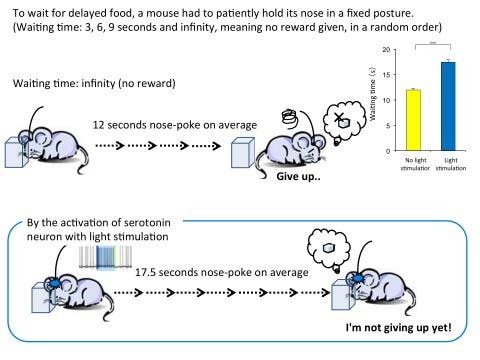
Either when someone’s late for a date or you need to queue in line, our patience becomes tested. Some people handle the waiting better than others, leading us to the idea that patience is a virtue that differs from person to person. But what is it exactly that helps us remain patient, and why do some people remain unfazed even when faced with hours, days even of waiting? The answer might lie in serotonin – one of the most widespread neutransmitter believed to influence a variety of psychological and other body functions. An imbalance in serotonin levels, for instance, has been linked with depression.
The finding came after Japanese researchers at the Neural Computation Unit at the Okinawa Institute of Science and Technology Graduate University used a new technique called optogenetics, where they use light to simulate specific neurons with precise timing.
Serotonin: rewarding patience
Serotonin is involved in a wide array of bodily and cognitive functions. Of the approximately 40 million brain cells, most are influenced either directly or indirectly by serotonin. This includes brain cells related to mood, sexual desire and function, appetite, sleep, memory and learning, temperature regulation, and some social behavior. In classic neuroscience, serotonin was believe to signal punishment and inhibit behaviors, however the opposite might be the case. Serotonin enriching drugs have been shown effective at treating depression, while previous optogenetic stimulation studies have shown that it’s linked with rewards. Also, research conducted by the same Japanese researchers found that inhibiting serotonin neurons causes impulsive behavior.
[ALSO READ] Scientists find brain region that helps you make up your mind
The mice who saw the light

(B) Blue light illumination, 500 microsecond pulse, shown in blue line, induced spontaneous action potentials in the serotonin neuron for approximately 10 seconds. The yellow light illumination, 500 microsecond pulse, shown in yellow line, stopped spontaneous action potentials. (fig. 1) Image: OIS
The researchers genetically engineered mice so that they produced light-activated molecules only in neurons that produce serotonin (fig. 1), then inserted an optical fiber in the backs of each brain. Five such mice were trained to performed a reward-delayed task, meaning they would receive a tasty treat if they waited at a hole. The game came in various stages; the mouse had to wait for 3 seconds, 6 seconds, 9 seconds or … infinity. The last stage meant that the mouse would never receive a reward – the ultimate patience test. To be sure the mice were actually patiently waiting, each mouse was trained to hold its nose in the hole while waiting for the reward. The researchers call this posture a ‘nose poke’. Ok, let’s move further.
No prior signal was released that would notify the mice how long the waiting would be, and the waiting periods themselves were shuffled at random.

The mouse easily could wait for 3 and 6 seconds to receive delayed food. When the duration was 9 seconds, the failure in waiting significantly increased. When serotonin neurons were activated with light stimulation during the 9-second delay, the number of reward wait failures significantly decreased.
In half of the trials, researchers stimulated serotonin neurons by shining a light through the optical fiber while the mice were waiting. The mice had no problem waiting for 3 or 6 seconds to receive the food, but from 9 seconds onward the rodents became fed up – and it wasn’t food. When serotonin neurons were stimulated with the light, the researchers found that the failure rate over 9 seconds significantly decreased (fig. 2).

In the 25% of trials, a food pellet was not presented no matter how long the mice waited. Without serotonin neuron stimulation, the mice waited 12 seconds on average. The waiting time was significantly extended to about 17.5 seconds on average with the stimulation of serotonin neurons.
In 25% of the trials, the researchers really messed with the mice’s heads – the food wasn’t rewarded no matter how long they had to wait. During these trials, mice with no serotonin stimulation waited on average 12.0 seconds, while those with serotonin neuron optical stimulation waited on average 17.5 seconds (fig. 3). For control purposes, the researchers were careful to shine light in serotonin neurons at different timing when the mouse did not have its nose poked in the food hole. They found that these mice behaved the same as in unstimulated cases. This suggests that serotonin doesn’t inhibit motor functions and, at the same time, that serotonin neurons promotes patience for delayed rewards.
“Our previous studies have shown that serotonin levels increase when waiting for delayed rewards. We have also shown that inhibiting serotonin neurons leads to an inability to wait for a long time,” explained Drs. Kayoko Miyazaki and Katsuhiko Miyazaki. “By using light to stimulate neurons at specific times, this study has proven serotonin’s role in patience during delayed reward waiting, underlining serotonin’s much greater role than previously thought.”
By further exploring the effect of serotonin, the researchers hope to decipher the neuronal network behind mental disorders and behaviors involving serotonin. Findings appeared in the journal Current Biology.






